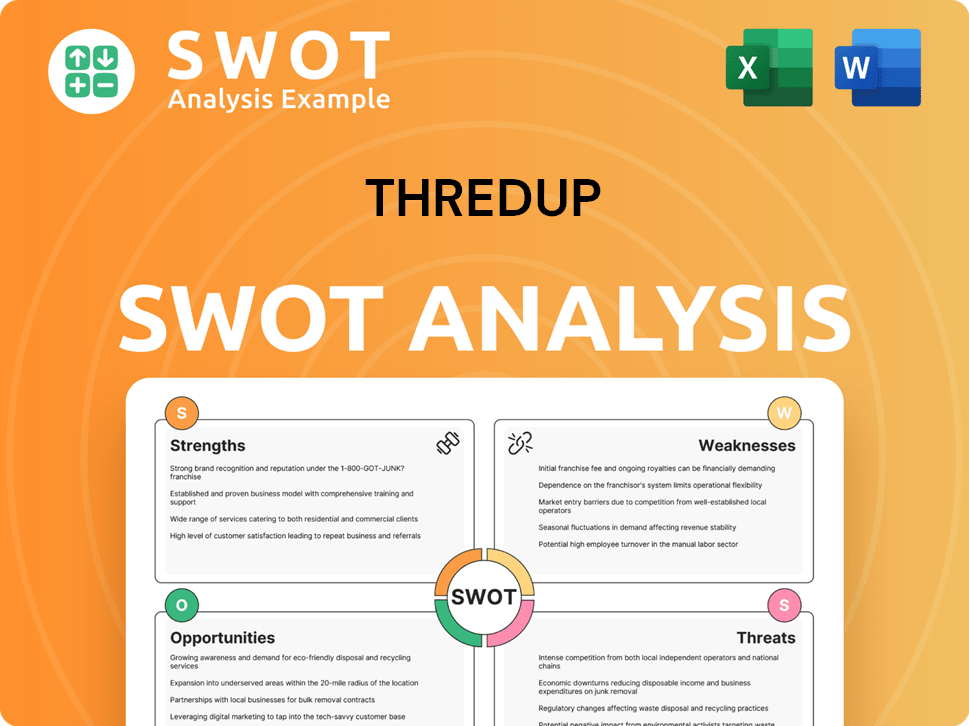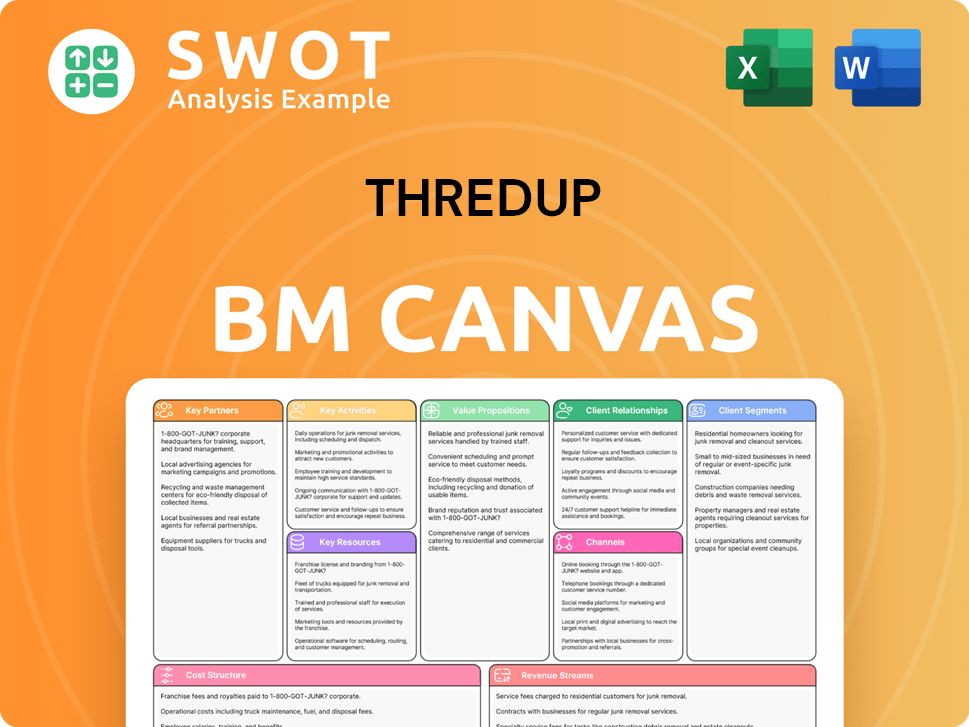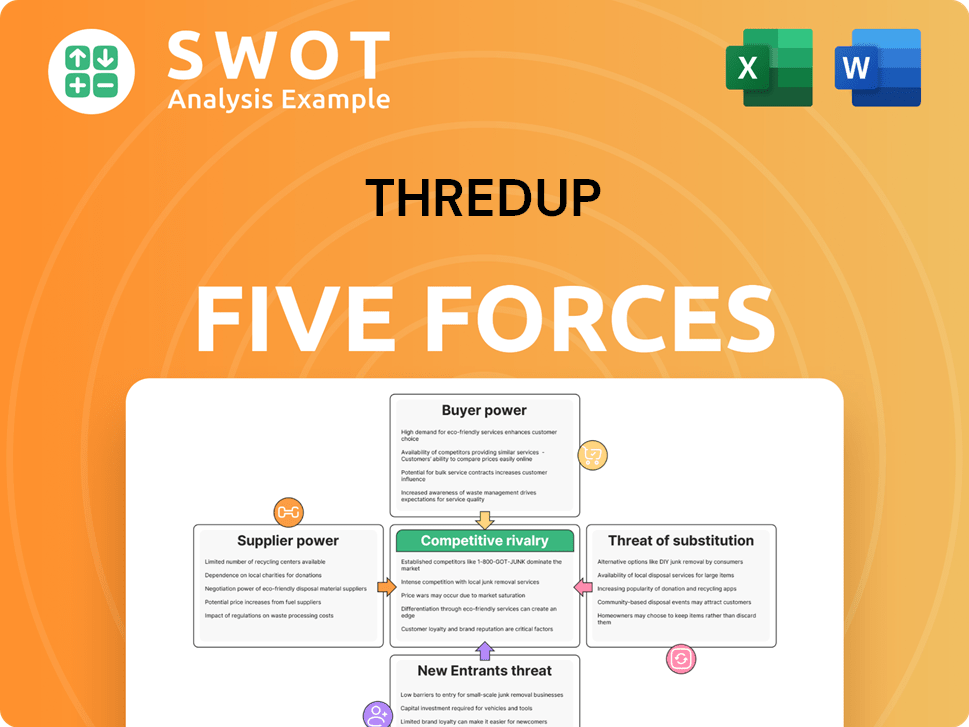ThredUp Bundle
Can ThredUp's Free RaaS Revolutionize Resale?
ThredUp, the online consignment pioneer, is shaking up the fashion industry with its commitment to the circular economy. With a recent move to eliminate fees for its Resale-as-a-Service (RaaS) platform, ThredUp is poised to redefine the resale landscape. This strategic shift could dramatically alter the ThredUp SWOT Analysis and its competitive standing.

This analysis dives deep into ThredUp's sales and marketing strategy, exploring how the company attracts and retains customers in the competitive online consignment market. We'll examine ThredUp's business model, dissecting its digital marketing approach, including its social media marketing strategies and SEO strategy, to understand how it drives growth. Furthermore, we'll explore ThredUp's customer acquisition strategies, brand positioning, and marketing campaigns to uncover the secrets of its success in the sustainable fashion movement and how it aims to capture a larger share of the booming resale market.
How Does ThredUp Reach Its Customers?
The core of the company's sales strategy relies heavily on its online presence. The company operates primarily through its e-commerce platform. This digital marketplace provides a straightforward way for individuals to buy and sell used clothing, simplifying participation in the circular economy.
A key element of the company's approach is its 'Resale-as-a-Service' (RaaS) program. This program allows retail brands to launch their own online resale storefronts, leveraging the company's technology and logistics. The company's strategic shift towards an open-source approach to branded resale aims to lower barriers for brands and encourage greater participation.
The online resale market is experiencing significant growth, which underscores the importance of online channels for the company's expansion. The company's partnerships through RaaS represent a strategic move into a hybrid model, enabling traditional brands to enter the online resale market. The company's recent launch of a curated vintage pop-up further diversifies its offerings.
The primary sales channel for the company is its e-commerce platform. This platform allows users to easily buy and sell gently used clothing. The company handles the entire process, from listing to shipping, making it convenient for users.
The RaaS program enables retail brands to launch their own resale storefronts. The company provides the technology, logistics, and cleaning services. By the end of 2023, the company had agreements with 47 brands.
The online resale market saw a 23% increase in 2024. This growth highlights the importance of online channels for the company. The market is projected to reach $40 billion by 2029.
The company's RaaS partnerships represent a move into a hybrid model. This allows traditional brands to participate in the online resale market. The recent launch of a curated vintage pop-up further diversifies product offerings.
The company's sales strategy is centered on its e-commerce platform and RaaS program. The company's focus on online channels is crucial for its growth. The company continues to explore new avenues like pop-ups to expand its reach and attract new customers. You can learn more about the Growth Strategy of ThredUp to understand its broader approach.
- E-commerce platform as the primary sales channel.
- RaaS program for brand partnerships.
- Focus on the rapidly growing online resale market.
- Diversification through curated vintage pop-ups.
ThredUp SWOT Analysis
- Complete SWOT Breakdown
- Fully Customizable
- Editable in Excel & Word
- Professional Formatting
- Investor-Ready Format

What Marketing Tactics Does ThredUp Use?
The marketing tactics of the company, a prominent player in the resale market, are multifaceted, combining digital strategies with data-driven insights to boost brand awareness and drive sales. Their approach emphasizes personalized campaigns and leverages customer data to target specific demographics effectively. This strategy is crucial for their ThredUp sales strategy and overall growth.
Digital marketing is a core component of their ThredUp marketing strategy. This includes content marketing, search engine optimization (SEO), paid advertising, email marketing, and active engagement on social media platforms. Influencer partnerships also play a significant role in expanding their reach and promoting products. The company's commitment to sustainability, highlighted through 'green marketing,' resonates with its target audience, driving customer acquisition and loyalty.
A key aspect of their approach involves integrating Artificial Intelligence (AI) and personalization to enhance user experience. This is evident in their AI-powered search tools and the recent launch of 'Shop Social,' an AI-driven social commerce experience. These initiatives aim to make secondhand shopping as convenient as buying new. This innovative use of technology supports their ThredUp business model and competitive advantage.
The company uses customer data to personalize marketing campaigns. This includes analyzing browsing history, purchase patterns, and demographic information to target specific customer segments. This approach is essential for effective customer acquisition strategies.
Digital marketing tactics include content marketing, SEO, paid advertising, email marketing, and social media engagement. Paid advertising spend in digital channels was under $100 million in the last year. Recent advertisements have been running on YouTube as of March 2025.
The company integrates AI to improve user experience, including AI-powered search tools recognized among TIME Magazine's 'Best Inventions of 2024.' They launched 'Shop Social,' an AI-powered social commerce experience in April 2025. These innovations enhance the online consignment shopping experience.
The company emphasizes sustainability by promoting the resale of clothing to reduce carbon emissions, water usage, and textile waste. This resonates with environmentally conscious consumers, supporting their brand positioning within the sustainable fashion market.
The company collaborates with influencers who align with their brand values and target audience. These partnerships help promote products and expand their reach, contributing to their ThredUp sales strategy.
The company's strategic initiatives have led to strong results, with new buyer growth increasing by 95% year-over-year in Q1 2025. This marks their best quarter for new buyer acquisition in history, showcasing the effectiveness of their ThredUp marketing strategy.
The company's marketing tactics are designed to drive growth in the resale market. They focus on digital channels, personalization, and sustainability to attract and retain customers. For more insights, check out the information about Owners & Shareholders of ThredUp.
- Data-Driven Personalization: Utilizing customer data for targeted marketing campaigns.
- Digital Marketing: Employing content marketing, SEO, paid advertising, email marketing, and social media.
- AI Integration: Implementing AI-powered search and personalized recommendations.
- Green Marketing: Highlighting sustainability efforts to attract environmentally conscious consumers.
- Influencer Marketing: Partnering with influencers to expand reach and promote products.
- Customer Acquisition: Focusing on strategies that drive new buyer growth, achieving a 95% year-over-year increase in Q1 2025.
ThredUp PESTLE Analysis
- Covers All 6 PESTLE Categories
- No Research Needed – Save Hours of Work
- Built by Experts, Trusted by Consultants
- Instant Download, Ready to Use
- 100% Editable, Fully Customizable

How Is ThredUp Positioned in the Market?
The brand positioning of the company centers on sustainability, affordability, and convenience, setting it apart in the competitive fashion resale market. It is a leading online consignment and thrift store, promoting the circular economy. Its core message encourages consumers to 'think secondhand first,' offering an easy way to buy and sell pre-owned clothing, shoes, and accessories. This approach is a key element of its ThredUp sales strategy.
Visually, the company maintains a clean and user-friendly online presence, reflecting its commitment to a seamless customer experience. The tone of voice is often empowering and environmentally conscious, directly appealing to consumers concerned about the environmental impact of fast fashion. The company's ThredUp marketing strategy targets women aged 25-44 who are environmentally conscious and value affordability. This strategy is designed to boost its ThredUp business model.
The company's unique selling proposition includes a wide selection of high-quality secondhand clothing at discounted prices, contributing to reducing textile waste. Brand consistency is maintained across its online platform and through its Resale-as-a-Service (RaaS) partnerships, where brands can integrate its technology while maintaining their own branding. This strategic approach is vital for its success in the online consignment sector and the broader resale market.
The company primarily targets women aged 25-44, who are environmentally conscious and value affordability. This demographic is key to its ThredUp customer acquisition strategies. The focus helps in refining its ThredUp marketing campaigns.
Sustainability is a core value, with the company actively promoting the circular economy and reducing textile waste. This emphasis on sustainable fashion resonates with its target audience. This is a crucial element of its ThredUp's brand positioning.
The company employs a strong ThredUp's digital marketing approach, including a user-friendly online platform. It focuses on ThredUp's social media marketing strategies to engage with its target audience. They also utilize ThredUp's SEO strategy to increase visibility.
Understanding the competitive landscape is crucial for the company. A thorough ThredUp's competitive analysis helps in refining strategies. This includes evaluating ThredUp's pricing strategy to stay competitive.
The company focuses on ThredUp's growth strategy by expanding its market reach and offerings. Its ThredUp's revenue model is based on sales and service fees. To learn more about the company's business model, check out this article: Revenue Streams & Business Model of ThredUp.
The company focuses on ThredUp's customer retention strategies to build long-term relationships. This includes providing excellent customer service and maintaining a user-friendly platform. Loyalty programs and personalized experiences are key.
The U.S. secondhand market grew five times faster than the broader retail clothing market in 2024, highlighting strong market position. According to the 2025 Resale Report, 46% of shoppers would avoid buying new items if a secondhand option were available. The company's responsiveness to consumer sentiment, such as the growing demand for sustainable fashion and online shopping, is a key factor in its success.
- The secondhand market is experiencing rapid growth.
- Consumers are increasingly choosing secondhand options.
- Sustainability and convenience drive consumer behavior.
- Online platforms are crucial for sales.
ThredUp Business Model Canvas
- Complete 9-Block Business Model Canvas
- Effortlessly Communicate Your Business Strategy
- Investor-Ready BMC Format
- 100% Editable and Customizable
- Clear and Structured Layout

What Are ThredUp’s Most Notable Campaigns?
The company's sales and marketing strategy prominently features targeted campaigns designed to boost brand awareness and drive customer engagement. A core component of this strategy involves the ongoing promotion of its 'Clean Out Kit' program, which streamlines the selling process for consumers and acts as a key source of inventory for the online consignment platform. This program is integrated with its branded resale shops, creating a smooth experience for both sellers and partner brands. The company's digital marketing approach is also a key element of its strategy, with significant investments in online advertising and social media marketing.
A recent and significant initiative is the launch of 'Shop Social' in April 2025, an AI-powered social commerce experience. This leverages the company's AI technologies to recommend styles, brands, and products based on shoppers' inspiration sourced directly from social media. This move is designed to make resale more accessible to younger generations who are active on social platforms, reflecting the evolving customer acquisition strategies. This strategic move aligns with the company's goal to remain competitive in the resale market and increase its customer base.
Another key aspect of the company's marketing strategy is the release of its annual Resale Report. These reports provide valuable insights into the secondhand market's growth and trends, positioning the company as an authority in the industry. The 2025 report, published in partnership with GlobalData, showed that the U.S. secondhand market grew 5 times faster than the broader retail clothing market in 2024. This data underlines the effectiveness of the company's marketing campaigns and its strong brand positioning within the sustainable fashion sector.
The continuous promotion of the 'Clean Out Kit' program is a cornerstone of the company's sales strategy. This program simplifies the process for consumers to sell their items, acting as a primary source of inventory. It's seamlessly integrated with the company's resale shops, enhancing the customer experience.
The 'Shop Social' initiative, launched in April 2025, leverages AI to recommend products based on social media inspiration. This campaign aims to engage younger shoppers and make resale more accessible on social commerce platforms. This digital marketing approach is key to reaching the target audience.
In May 2025, the removal of resale fees for brands and retailers from its RaaS offering was announced. This strategic move incentivizes brands to embrace circularity. This is a powerful marketing message designed to attract new brand partnerships and increase inventory.
The annual Resale Report, published in partnership with GlobalData, serves as a thought leadership campaign. These reports provide valuable insights into the secondhand market, reinforcing the company's authority. The 2025 report highlights the rapid growth of the U.S. secondhand market.
These campaigns have contributed significantly to the company's growth and brand recognition. The focus on digital marketing and innovative programs has driven strong results.
- The U.S. secondhand market grew 5 times faster than the broader retail clothing market in 2024.
- New buyer acquisition saw a 95% year-over-year growth in Q1 2025.
- 39% of younger generation shoppers made a secondhand purchase on a social commerce platform in the past year.
ThredUp Porter's Five Forces Analysis
- Covers All 5 Competitive Forces in Detail
- Structured for Consultants, Students, and Founders
- 100% Editable in Microsoft Word & Excel
- Instant Digital Download – Use Immediately
- Compatible with Mac & PC – Fully Unlocked

Related Blogs
- What are Mission Vision & Core Values of ThredUp Company?
- What is Competitive Landscape of ThredUp Company?
- What is Growth Strategy and Future Prospects of ThredUp Company?
- How Does ThredUp Company Work?
- What is Brief History of ThredUp Company?
- Who Owns ThredUp Company?
- What is Customer Demographics and Target Market of ThredUp Company?
Disclaimer
All information, articles, and product details provided on this website are for general informational and educational purposes only. We do not claim any ownership over, nor do we intend to infringe upon, any trademarks, copyrights, logos, brand names, or other intellectual property mentioned or depicted on this site. Such intellectual property remains the property of its respective owners, and any references here are made solely for identification or informational purposes, without implying any affiliation, endorsement, or partnership.
We make no representations or warranties, express or implied, regarding the accuracy, completeness, or suitability of any content or products presented. Nothing on this website should be construed as legal, tax, investment, financial, medical, or other professional advice. In addition, no part of this site—including articles or product references—constitutes a solicitation, recommendation, endorsement, advertisement, or offer to buy or sell any securities, franchises, or other financial instruments, particularly in jurisdictions where such activity would be unlawful.
All content is of a general nature and may not address the specific circumstances of any individual or entity. It is not a substitute for professional advice or services. Any actions you take based on the information provided here are strictly at your own risk. You accept full responsibility for any decisions or outcomes arising from your use of this website and agree to release us from any liability in connection with your use of, or reliance upon, the content or products found herein.